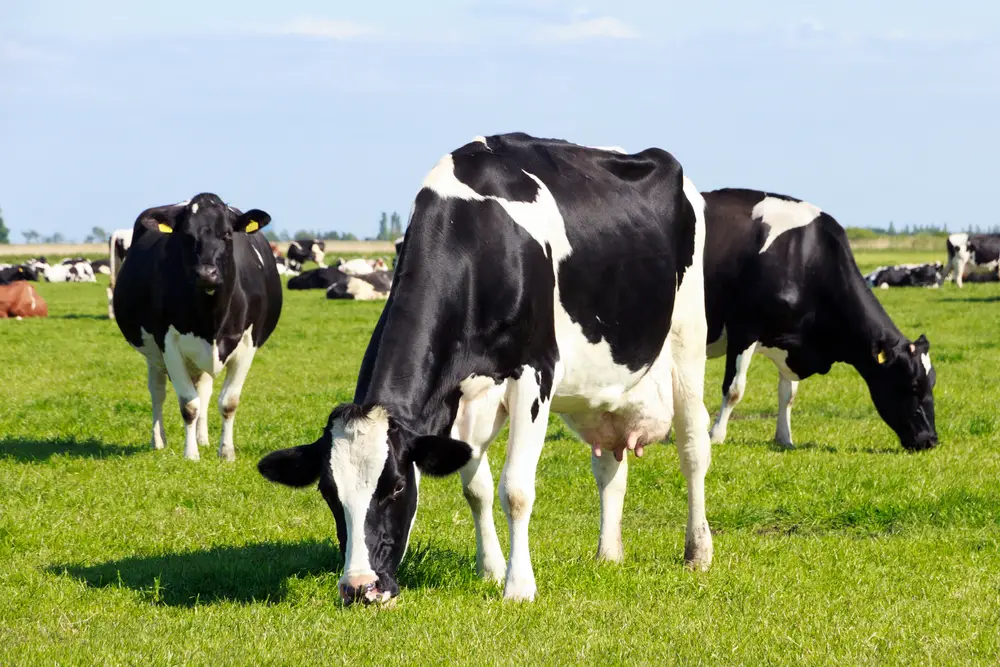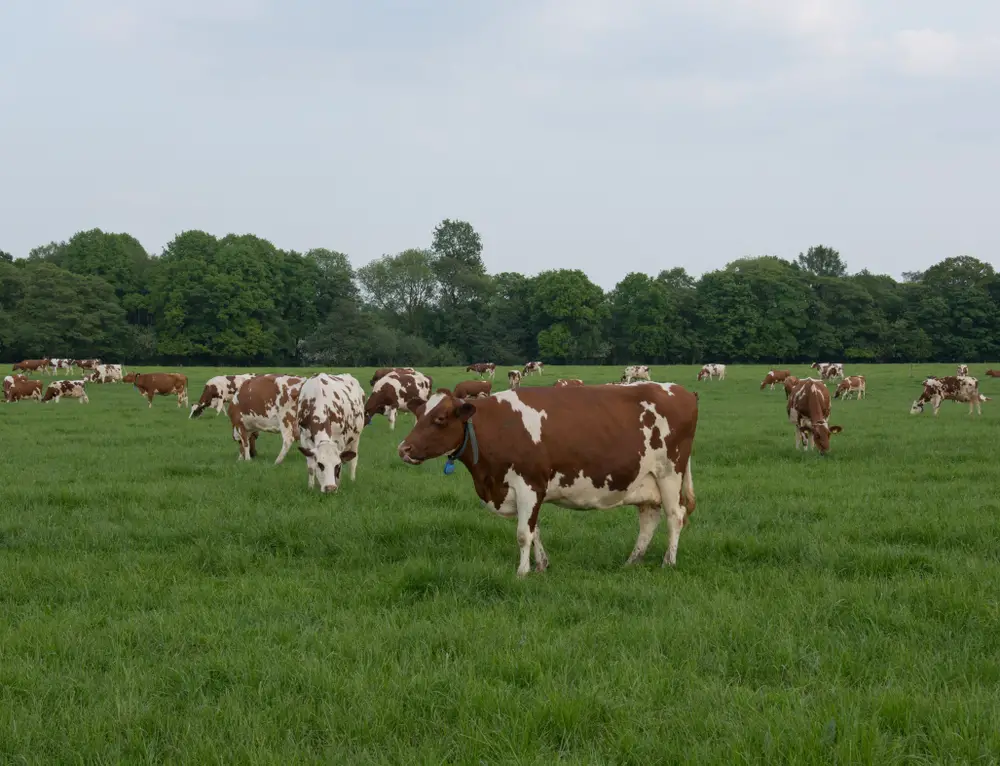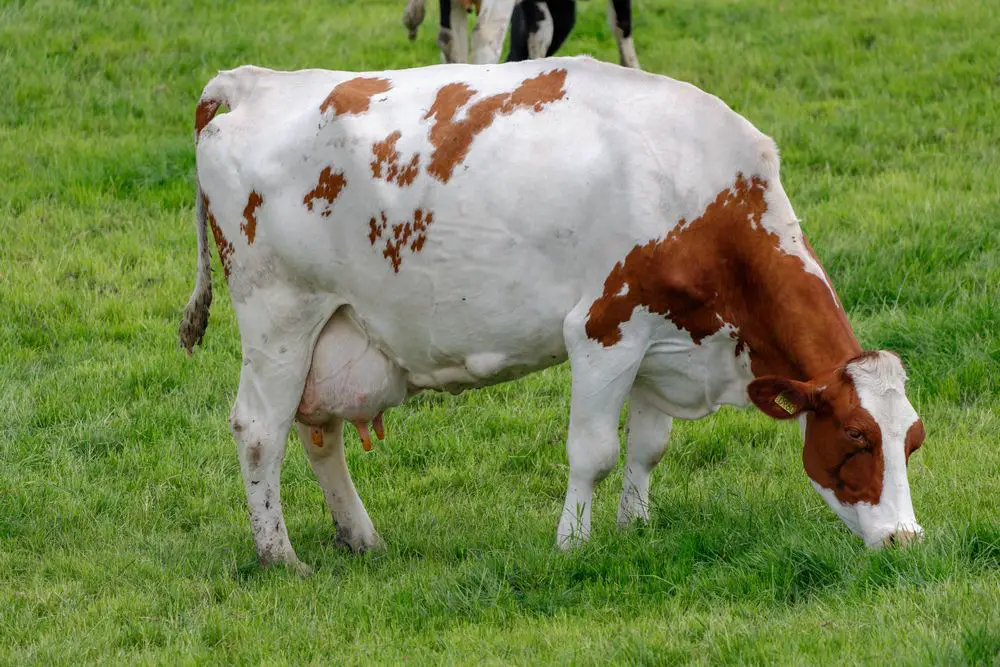Popular dairy cows in the United States include Holstein, Jersey, Brown Swiss and Guernsey. The country produces more milk annually than any other country in the world, with an estimated 9.38 million dairy cows as of 2022.
Despite such a large number of dairy cows, the majority are from the following 7 dairy breeds, which have proven popular and beloved not only stateside, but worldwide.
Table of Contents
Most Popular Dairy Cows
1. Holstein
The most popular milking dairy cow, Holsteins can be found on 90% of dairy farms in the United States. Holsteins are black with white spots and are the most recognizable of all dairy breeds.

Holsteins are one of the larger dairy breeds and at maturity weigh 1500 pounds. They produce their first calf between 23 and 26 months of age.
Holstein cows are originally from the Holland provinces in the Netherlands and are known for their incredible milk production capabilities, producing 23,000 pounds of milk annually.
Holsteins are often crossbred with other dairy breeds to combine the best attributes of both breeds, such as the Holstein-Friesian, a cow known for hardiness, ease of handling, and superior milk production.
2. Jersey
Jersey cows make up around 7 percent of the dairy cattle in the United States and are originally from the Isle of Jersey, one of the islands found in the English Channel.

Jersey cows are usually a beautiful honey-brown color and have large, expressive eyes with long eyelashes. They weigh 1000 pounds at maturity and are one of the smaller dairy breeds.
Jersey cows are known for giving milk that is a pale yellow color and high in butterfat.
Jersey cows can produce 6 gallons of 5% milk a day, equating to 16,000lbs per year. Due to their longevity of production, they often are more profitable than Holstein cows.
3. Brown Swiss
The predecessors to American Brown Swiss cows come from the alps of Switzerland and are one of the oldest breeds of dairy cows. They are descendants of triple-purpose cows that were originally used for beef production, draught purposes, and milking.

The American Brown Swiss differs from its ancestors and is no longer raised as beef cattle as it has been selectively bred for milk production. Brown Swiss cows produce 22,600lbs of milk annually, nearly as much as Holstein cows!
Brown Swiss milk is perfect for cheesemaking, with 4% butterfat and high protein.
Brown Swiss cows have high adaptability and are known for their docile temperament. They typically weigh 1300lbs to 1400lbs and can be different colors including dark brown, gray, tan, or white.
4. Guernsey
Originally from the Isle of Guernsey, Guernsey cows are medium-sized cows that weigh around 1,200lbs. They produce around 16,200lbs of milk annually.

They are a golden, white, or fawn color and are known to have strongly attached udders and excellent conformation.
Guernsey cows are known for the golden color of their milk which comes from high butterfat, and the beta carotene content of it. Beta carotene turns into Vitamin A in the body, and Guernsey cow’s milk is highly prized as a natural source of vitamin A.
Guernsey cows are known for needing less feed than other dairy breeds, up to 30 percent less without it affecting milk output. This makes Guernsey cows attractive to farmers looking for solid milk production with lower management costs.
5. Ayrshire
Ayrshire cows come from the County of Ayr in Scotland and are known for their longevity and vigor. They have high feed efficiency and are the result of crossbreeding between imported Dutch cattle and native Scottish cattle.

Ayrshire cows weigh around 1200lbs and are a medium size with a red and white color pattern. They are able to withstand harsh climates and have excellent adaptability.
The milk from an Ayrshire cow has 4 percent butterfat and an impressive 8.8% nonfat solids which produce high-quality cheese. The color of the milk can be white to a light yellow, and an Ayrshire cow produces between 12,000 and 20,000 pounds of milk annually.
6. Red and White Holstein
Red and White Holsteins are large dairy cows, weighing around 1400lbs. They are the sole dairy cow with bloodlines from different breeds of dairy cattle that is considered a purebred by the Purebred Cattle Association.

Red and White Holsteins have red and white markings. However, they were not originally favored by breeders as the recessive gene causing red coloring meant exclusion from registries that would only register Holsteins that were black and white.
The Red and White Dairy Cattle Association was founded in 1964 to promote the Red and White Holstein, and since then their population has grown significantly.
Red and White Holsteins are known for prodigious dairy production, producing 23,000lbs of milk per lactation period.
7. Milking Shorthorn
Milking Shorthorn cows were one of the first breeds of dairy cattle imported to the United States in the late 1700’s, and prior to the introduction of Holstein cows, were used widely as milk cows by dairy farmers. They were popular because of their docility and versatility.

Milking Shorthorns were developed as a dual-purpose breed, and were used for beef production and milk production.
Dairy herds containing Milking Shorthorns are recognizable because of their red, red and white, or roan coloring, and medium size, weighing 1100lbs. They are popular in the United States, Canada, England, Australia and New Zealand because of their fertility, feed efficiency, and long productivity.
Milking Shorthorn milk has 3.8 percent fat and 3.5 percent protein. They produce 15,000lbs of milk each year. They are known for low somatic cell scores, and have less cases of mastitis and disease than other breeds.
FAQs
What Do Dairy Cows Eat?
Dairy cows eat a diet that is high in forage (this includes pasture grass and silage) and may eat the stems and leaves from grains like oats, wheat, and corn.
Dairy cows may also be fed supplements such as minerals and vitamins, along with high-protein sources such as soybean meal.
Their diets must be optimized and balanced for their needs including their age, weight, and pregnancy status. Lactating cows will need much more feed than cows that aren’t producing milk – as much as 100 pounds per day.
How Do You Choose A Dairy Cow Breed?
Before choosing a dairy breed, you’ll need to consider:
- Milk production amount per lactation period
- Milk content including butterfat, solids, and protein depending on what it will be used for
- Fertility, including the ability to get pregnant and birth healthy calves annually
- Productive longevity and lifespan
- Temperament and ease of handling
- Feed efficiency
- Health, hardiness, and adaptability
It is important to consider all of these factors when choosing the best dairy breed for your farm. Ultimately the value that you get out of a particular dairy herd needs to be sustainable and profitable.
It is a good idea to figure out what your particular market supports before choosing your dairy breed. Essentially, you’ll want buyers ready who are eager for the product that your cows can provide, and well before you purchase your first dairy cow.
